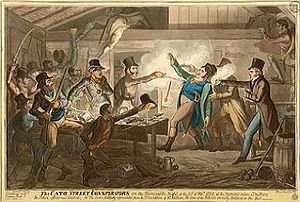After Napoleon was finally dispatched to St. Helena, Britain settled its foreign affairs to find the home state in midst of crisis. The Industrial Revolution had drastically changed the demographics of the nation and thousands had been forced out of old jobs replaced by new technology, such as the weavers displaced by the automatic loom. Luddites had attempted to fight the change with violence, leading to suppression by the British government in 1811. While that had cooled some tempers, rising tension continued as more and more manual jobs were given to machines. Thousands of soldiers returning from the Napoleonic Wars worsened the unemployment.
A revolutionary social club called the Spencean Philanthropists had formed in honor of orator Thomas Spence and liberal ideals. While some members were primarily dedicated to propaganda and publishing, others were men of action, such as leader Arthur Thistlewood. In 1816, he and several others instigated a series of riots in Spa Fields, Islington, aimed at gathering enough force to storm the Tower of London and seize the Bank of England. While marches of some twenty thousand did take place, the small group that actually attempted to approach the Tower was dispersed by soldiers. Ringleader Dr. James Watson, Thistlewood, and others were arrested, but released after exposure of a government spy who had helped suggest the riots.
Mass public gatherings continued, and the British government under Prime Minister Lord Liverpool decided to take action. On August 16, 1819, the cavalry charged a group of over 60,000 protestors at St. Peter’s Field in Manchester who were marching for representation reform as only males owning land valued at forty shillings were allowed to vote. More than a dozen were killed and hundreds injured, spurring shock across Britain as newspapers covered what came to be known as the “Peterloo Massacre.” In response, the government increased its suppression in the next months with the Six Acts, which banned unlawful training, gave magistrates the right to seizing arms and require permission for rallies, and reduced free press.
Thistlewood and his cohorts were infuriated by Parliament. Following the death of George III on January 29, 1820, Thistlewood’s second-in-command George Edwards suggested that they act: kill the Prime Minister and his cabinet and seize the government in the lull between kings. They determined their plan on February 22 and roused up twenty-seven men ready to act. Jamaican William Davidson, who had once served the Earl of Harrowby, Lord President of the Council and host of the dinner they planned to attack, stopped by for details and discovered Harrowby was not at home. When he mentioned this to Thistlewood, the latter recalled the agent provocateur at the Spa Fields riots and that Edwards had been eager about the sudden idea of an attack.
Thistlewood and his comrades began a midnight purge of their organization, discovering both Edwards and George Ruthven to be spies for the British Home Office. Ruthven confessed his plan to meet with a dozen Bow Street Runners (the newly formed police force) and apprehend the Spenceans at the loft they had rented on Cato Street. Holding the spies prisoner, Thistlewood announced that plans should go forward immediately as soon as the cabinet members could be found. While there was no dinner at Harrowby’s home, the other cabinet members were found at their own homes and massacred in coordinated attacks infamous for their use of grenades. Harrowby himself was hunted by a team who left London in pursuit that afternoon. True to his boasts, coffee shopkeeper John Ings decapitated two men and placed their heads to Westminster Bridge, where he was apprehended by shocked Coldstream Guards.
Thistlewood and the conspirators who had not been killed barricaded Mansion House and declared themselves a Committee of Public Safety to oversee the transition to a new representative government. Their fliers depicted revolution akin to that seen in France thirty years before. Within days, Britain was “set alight” by revolutionaries marching while loyalists defended the remaining government.
The idea of a revolution mirroring that of France, however, proved overall unappetizing. While most were ready for reform, few wanted the horrors of the guillotine, the Terror, and, perhaps ultimately, a British Napoleon. The loyalist soldiers of Britain rallied behind the Duke of Wellington, who had seen the fires of London from his home of Apsley House on the outskirts. Taking up arms, he marched on Mansion House, capturing and later executing the conspirators following military trial. Much of England fell under martial law, and instigators of violence were rooted out. Wellington was granted unprecedented powers as a new Prime Minister, and, though he was able to provide for Catholic Emancipation, he continued Britain as a rigidly censored place. Revolutionary ideals were mistrusted, as was seen for decades after in the arrest and exile of communist Karl Marx in 1850.
--
In reality, Thistlewood did not suspect Edwards, who turned over the conspiracy to the Home Office. The men were arrested in a brawl, and conspirators Robert Adams and John Monument testified against the others under the promise of dropped charges. Five men, including Arthur Thistlewood, William Davidson, and John Ings, were hanged at Newcastle prison, though original sentences added drawing and quartering, which were commuted. Five others were sent to penal colonies, a show of reform which was gradually coming to Post-Napoleonic Europe.

No comments:
Post a Comment